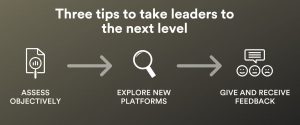
Today’s business leaders are expected to do more than ever before to guide their teams through unprecedented times that are filled with ambiguity and new frontiers.
 Many must now lead and develop remote or hybrid employees and instill a sense of teamwork and culture across an increasingly distributed workforce. Managers must also understand the unique needs of a diverse set of constituents, as well as overcome the challenges of the Great Resignation by providing more career advancement and personalized training to retain promising talent.
Many must now lead and develop remote or hybrid employees and instill a sense of teamwork and culture across an increasingly distributed workforce. Managers must also understand the unique needs of a diverse set of constituents, as well as overcome the challenges of the Great Resignation by providing more career advancement and personalized training to retain promising talent.
In the past, managers were often chosen based on their experience and technical skills. However, leaders must now possess a well-rounded skill set that includes emotional intelligence, communication abilities, and creativity. Accordingly, leadership development and training methods must keep pace to adequately prepare managers to navigate this evolving landscape. Today, programs must provide newer and better opportunities for candidates to learn and develop the skills they need to succeed.
The traditional leadership development model was limited, inflexible, and often inconvenient for learners. Current leadership development programs have evolved in tandem with the growth of online learning platforms. For example, emerging leaders now prefer more integrative, on-demand courses like those found on LinkedIn Learning and TED. The advent of technology-based platforms for training delivery has provided a means for more accessible, self-paced training on demand.
How can you stay ahead of the curve and ensure that you’re providing the best possible learning experience for employees? By following some of the latest trends in leadership development and training. Let’s take a look.
UNDERSTAND DIFFERENT TYPES OF LEADERS
First, to provide the best possible training, leadership development programs must address different types of leaders. There are two basic categories of leaders: emerging leaders and those with experience who need refinement.
Emerging leaders are those who have the potential to become great leaders, but they may not have all the skills required. They are often in the early stages of their career and may be new
to a leadership role. The best way to train emerging leaders is through active learning opportunities, which include methods such as experiential learning, online learning, and social learning. These methods allow learners to interact with others, learn from their experiences, and apply what they’ve learned in a real-world setting.
Experienced leaders often need refinement. They may have the skills required for a leadership role, but they may not be using them in the best way possible. Training experienced leaders usually involves providing them with more active mentoring, feedback, and coaching, in addition to some of the approaches described earlier.
LEVERAGE TECHNOLOGY IN LEADERSHIP DEVELOPMENT
Leaders are also increasingly turning to technology for learning and development opportunities. Technology-based methods provide a means for flexible, accessible training no matter where employees are—literally and figuratively. These types of approaches include flexible online learning platforms, soft skills focus, gamification techniques, and experiential learning.
One of the trending ways to deliver leadership development training is the use of flexible online learning platforms. These platforms allow learners to access content anywhere, anytime, and on any device. They also provide a variety of features that can enhance the learning experience, such as video content, social media interaction, and gamification.
In addition to technical skills, managers need to develop a variety of soft skills in order to be successful. These typically include listening, empathy, collaboration, and more. One way to develop soft skills is through active learning opportunities where leaders can interact more with technology and give and receive feedback. For example, employees can take online courses that use interactive tools such as discussion forums and chat rooms.
Gamification is the process of using game mechanics in non-game contexts. This can include points, badges, leaderboards, and friendly competition. Gamification has been shown to be an effective way to engage learners and increase motivation. In addition to being fun, games also can be a powerful tool for learning. Virtual reality (VR), for example, offers a realistic, immersive experience that can help learners understand new concepts and environments. It also can be used to train people on how to handle difficult situations. For example, a leader might use VR to practice dealing with a difficult customer or teammate or to learn about a new culture.
Experiential learning involves hands-on experience and reflection. It allows leaders to apply what they’ve learned in a real-world setting. One way to provide experiential learning is through technology-based leadership development programs that offer simulations. These programs allow participants to role-play different scenarios, such as leading a team, making decisions under pressure, and handling conflict.
EMBRACE EFFECTIVE LEADERSHIP TECHNIQUES
In addition to technology-based learning opportunities, there are a couple of other trends in leadership development that have been proven to show results in improving desired skills. One popular way to use technology for leadership development is through microlearning. This type of learning approach delivers short, focused lessons that are easy to absorb. Microlearning is ideal for busy leaders who want to learn on their own schedule. With the ability to provide short lessons and give leaders the chance to practice new skills on the job, microlearning creates stronger learning experiences and makes retention easier. By breaking down content into manageable chunks and then reviewing and practicing skills, leaders are more likely to apply these lessons on the job.
It also supports long-term habit-building to create lasting positive behaviors. Delivering training in small steps and providing feedback and positive reinforcement along the way make it easier for people to digest and incorporate in their daily routines.
Leaders also want learning experiences that are tailored to their individual needs. This can be done through the use of adaptive learning software, which adjusts the content and difficulty level based on the learner’s performance. In addition, leaders can benefit from personalized coaching and mentoring relationships. By addressing the whole person, you can better understand their strengths, weaknesses, goals, and personality traits. From there, you can create a training program that aligns their aspirations with the company’s needs.
“ By addressing the whole person, you can better understand their strengths, weaknesses, goals, and personality traits.”
ENHANCE RETENTION WITH LEADERSHIP DEVELOPMENT
Organizations with high retention rates are holding onto their employees for a reason. These companies have realized that you can teach leadership skills to someone who is still an individual contributor because that person needs to lead. Leadership can occur in many forms, such as meetings, projects, and day-to-day activities. Creating an environment where employees can use their leadership skills to make a difference is what keeps people motivated and eager to stay.
Ask yourself the following questions:
Are you inspiring your team? Are you giving people tough assignments, challenging them, and pushing them to go past the status quo so that they can continue to grow? When you grant employees the autonomy to execute projects by enabling them with the right skill set, a collaborative and inspiring culture is born. That’s why today’s leadership development solutions must focus on teaching the right skills to the right individual in the right way, so that they are given the best opportunity to advance to their truest potential.
Is there a defined career development path? People who
can see a defined career path in their company are much more likely to stick around. Offering leadership development opportunities is one way to show employees that you care about their long-term growth and are invested in their success. There needs to be a continuous conversation about career paths and aspirations. Identify what opportunities employees are seeking in their current role and give them room to practice new skills while being supported. This combination allows employees to reflect on their learning and simultaneously strive to perform better in their roles.
THREE TIPS TO TAKE LEADERS TO THE NEXT LEVEL
Employing successful leadership development really boils down to understanding how the brain learns in order to create learning environments that are more effective, empowering, and engaging. Recognize, however, that it’s an ongoing learning process. No leaders were born overnight, and oversight is critical to ensuring an optimal outcome. Following three simple steps will help take your leaders to the next level:
Assess objectively. Professional objective assessments are a valuable tool for leadership development. They provide insights into employees’ personal preferences and how they might react in certain situations. For example, if someone is driven by money and power, they will do things very differently than if they are motivated by a cause. Recognizing these traits can help you to better define a personalized leadership experience that will result in true growth versus a “one size fits all” approach.
Explore new platforms. We know so much more about the human brain than we used to, including how short a typical attention span is. We know that our brains need sleep to help us “store” information for later recollection. We must provide boosters and regular triggers after training to enhance memory recall, and we know that tying new information to existing knowledge will help it stick. By taking advantage of technology-based leadership development platforms like Vayability, which apply valuable insights from neuroscience, we can help learners achieve long-lasting impact. Give and receive feedback. Leaders learn and grow from continuous feedback, not just during training but also in the support they should receive afterward. When provided frequently, feedback sheds light on what behaviors they should continue doing, stop doing, or start doing. Feedback is, however, a two-way street. Employers should likewise be receptive to receiving input from their leaders throughout the development process to continue to refine and improve future leadership training content and approaches for others.
Give and receive feedback. Leaders learn and grow from continuous feedback, not just during training but also in the support they should receive afterward. When provided frequently, feedback sheds light on what behaviors they should continue doing, stop doing, or start doing. Feedback is, however, a two-way street. Employers should likewise be receptive to receiving input from their leaders throughout the development process to continue to refine and improve future leadership training content and approaches for others.
TURN TRENDS INTO ACTION
Keeping these trends in mind, it’s important to evaluate leadership development programs carefully. When selecting a program, look for certain attributes that are geared to today’s learners, such as personalized rather than classroom training, the application of neuroscience to cultivate long-term habits, and on-demand platforms that make learning accessible. Couple online training with live coaching, and give leaders the opportunity to practice new skills in a safe environment with continuous support. Be sure that your leadership development program offers the ability to capture measurable outcomes to prove ROI. If these key components are included, you can be sure that your leadership development program is on the cutting edge of what’s new and next. AQ
Paul Eccher, PhD, president and CEO of Vaya Group, has more than 25 years of experience partnering with Fortune 500 clients to leverage talent to achieve improved business results.






